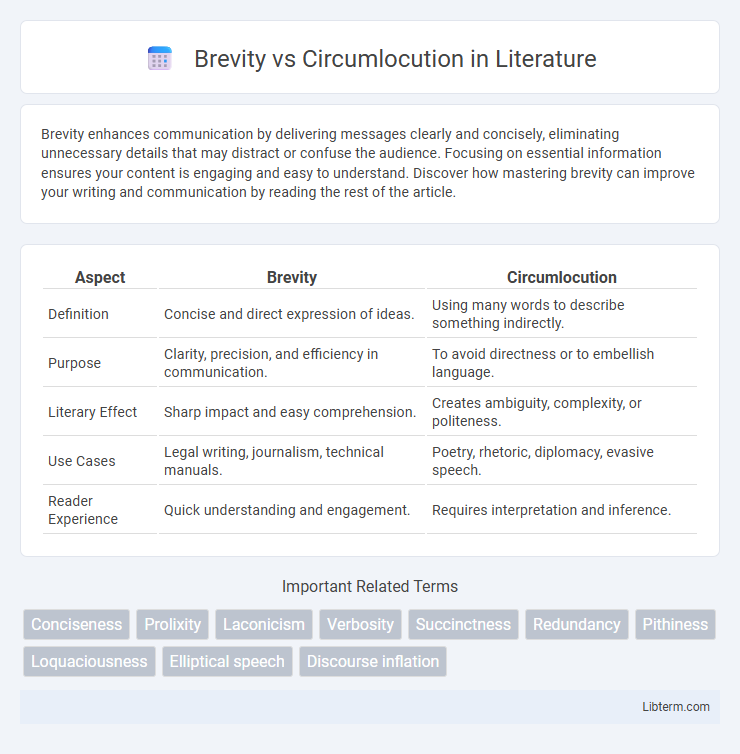Brevity enhances communication by delivering messages clearly and concisely, eliminating unnecessary details that may distract or confuse the audience. Focusing on essential information ensures your content is engaging and easy to understand. Discover how mastering brevity can improve your writing and communication by reading the rest of the article.
Table of Comparison
| Aspect | Brevity | Circumlocution |
|---|---|---|
| Definition | Concise and direct expression of ideas. | Using many words to describe something indirectly. |
| Purpose | Clarity, precision, and efficiency in communication. | To avoid directness or to embellish language. |
| Literary Effect | Sharp impact and easy comprehension. | Creates ambiguity, complexity, or politeness. |
| Use Cases | Legal writing, journalism, technical manuals. | Poetry, rhetoric, diplomacy, evasive speech. |
| Reader Experience | Quick understanding and engagement. | Requires interpretation and inference. |
Understanding Brevity and Circumlocution
Brevity emphasizes concise communication by using the fewest words necessary to convey a clear message, enhancing clarity and efficiency. Circumlocution involves expressing ideas in a roundabout or indirect way, often using more words than needed, which can obscure meaning and reduce comprehension. Understanding the balance between brevity and circumlocution is crucial for effective communication, ensuring messages are both precise and sufficiently detailed.
The Art of Concise Communication
The art of concise communication hinges on brevity, delivering clear and direct messages that maximize impact while minimizing unnecessary words. Avoiding circumlocution enhances understanding by eliminating redundant or convoluted expressions, allowing core ideas to stand out effectively. Mastering this balance improves engagement, fosters clarity, and ensures efficient information exchange in both written and verbal communication.
Circumlocution: Causes and Consequences
Circumlocution occurs when a speaker or writer uses unnecessarily wordy or indirect expressions to explain a concept, often due to limited vocabulary, uncertainty, or a desire to appear more sophisticated. This verbose approach can lead to confusion, misinterpretation, and reduced clarity, negatively affecting communication efficiency and audience engagement. Prolonged reliance on circumlocution may hinder effective information exchange and obscure the intended message, making concise alternatives more desirable.
Benefits of Being Brief
Being brief enhances clarity by delivering messages in a concise, straightforward manner, reducing the risk of misunderstanding. It improves efficiency in communication, saving time for both the speaker and the listener. Brevity also strengthens the impact of key points, making them more memorable and persuasive.
When Circumlocution is Effective
Circumlocution is effective when clarity requires explaining complex concepts, avoiding ambiguity, or softening sensitive topics. In legal, diplomatic, or academic writing, it helps to navigate nuanced subjects and ensures precision without oversimplification. This technique enhances communication by providing rich context where brevity might sacrifice necessary detail or politeness.
Comparing Brevity and Circumlocution in Writing
Brevity in writing emphasizes clarity and conciseness, using as few words as possible to convey a message effectively. Circumlocution, by contrast, involves a roundabout or indirect way of expressing ideas, often leading to verbosity and ambiguity. Comparing brevity and circumlocution highlights the importance of precise language, where brevity enhances readability and impact, while circumlocution can obscure meaning and reduce engagement.
Impact on Reader Engagement
Brevity enhances reader engagement by delivering clear, concise messages that respect the audience's time and improve comprehension. Circumlocution often diminishes engagement, as lengthy, indirect expressions can confuse readers and dilute the core message. Effective communication strategically favors brevity to maintain attention and maximize impact.
Common Pitfalls of Over-Explaining
Over-explaining often leads to circumlocution, where redundant phrases obscure the main point and reduce clarity. Common pitfalls include unnecessary details that overwhelm readers, diminishing engagement and comprehension. Effective communication balances brevity with sufficient context to convey meaning without verbosity.
Strategies for Achieving Brevity
Strategies for achieving brevity include prioritizing clear and concise language, eliminating unnecessary words, and using active voice to convey information directly. Employing precise vocabulary and focusing on the main message reduces complexity and improves readability. Tools such as bullet points, summaries, and editing for redundancy enhance the effectiveness of brief communication.
Striking the Right Balance
Striking the right balance between brevity and circumlocution involves delivering clear, concise messages while providing enough context for full understanding. Effective communication uses brevity to avoid ambiguity and maintain reader engagement, yet employs circumspect phrasing when nuanced explanations or detailed descriptions are necessary. Mastering this balance enhances clarity, ensures precision, and adapts to diverse audiences and purposes.
Brevity Infographic

 libterm.com
libterm.com